Mayflower 400: Old Worcestershire & New Plymouth (Part I)
- 16th September 2021
The Mayflower occupies a significant place in the story of the United States of America. Just as significant is the event the following autumn which led to today’s annual Thanksgiving celebrations each year. Worcestershire has Mayflower connections, through the Winslow family. We have shared this before on our Thanksgiving blog. Anthony, one of our Archive Assistants, has been looking further into the story, after seeing the exhibition down in Plymouth and reading some of the latest research. In Part 2 he looks at Winslow over in America.
As a Plymouthian, for me, it cannot be overstated how three events arguably shaped the history of Plymouth today and the history lessons I received in my youth. The first was the threat of the Spanish Armada and Sir Francis Drake’s involvement – famously reported to have been playing a game of bowls on Plymouth Hoe on 20th July 1588 when news first reached him of the invasion. He continued unperturbed; a reaction fabled as an act of English bravery. The second, over 350 years later occurred as Plymouth, a strategic port, was again threatened with invasion, this time from Nazi Germany. It was heavily bombed during the Second World War and led to the radical reshaping of the city under Sir Patrick Abercrombie’s post-war plan. The other event which looms large in the zeitgeist of Plymouth and British history is that of ‘The Pilgrims’ separatists’ voyage on board ‘Mayflower’ in 1620 to escape persecution and start a new life and colony in the ‘New World’.
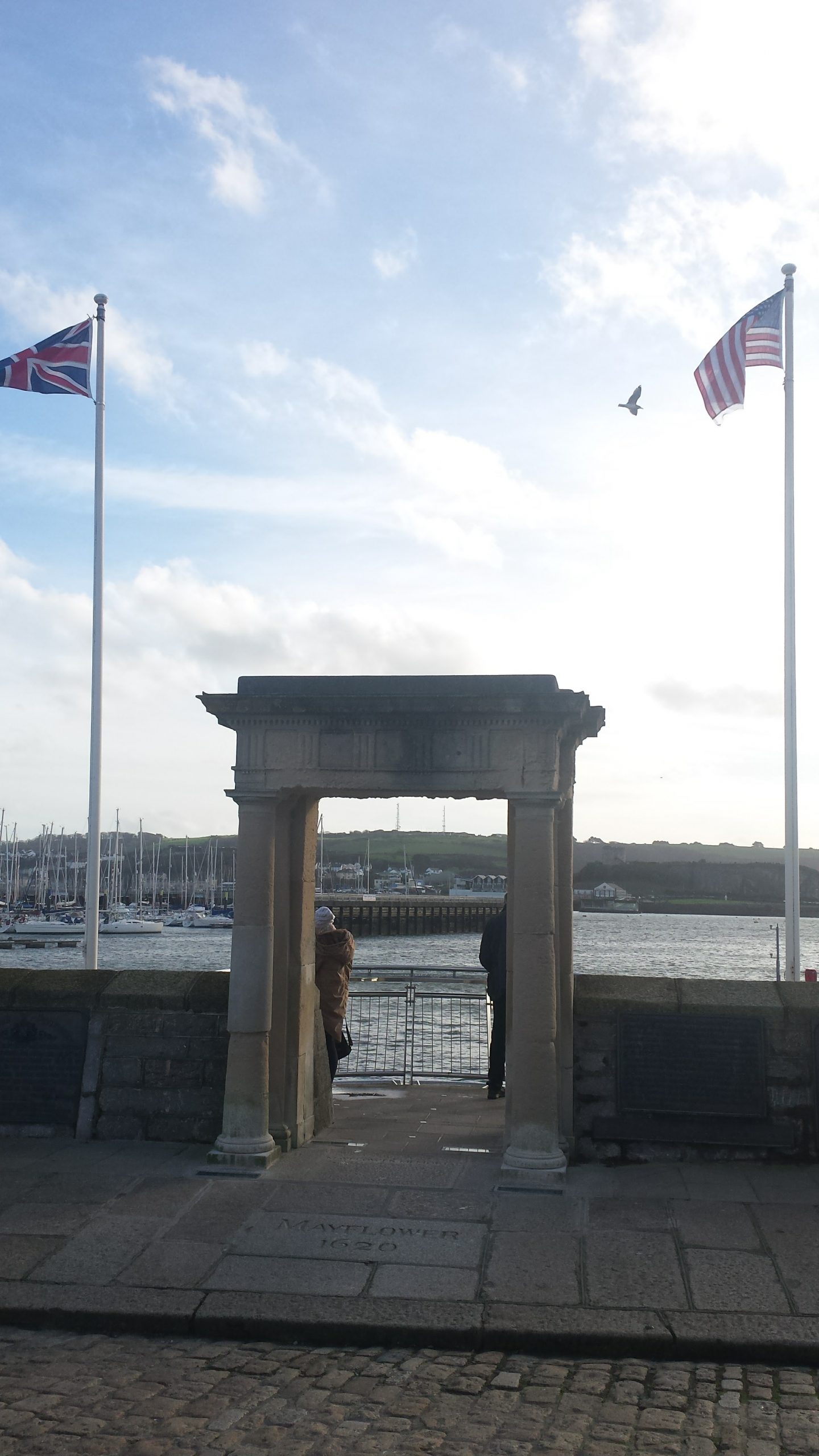
The Mayflower Steps, Plymouth © Anthony Roach
I certainly could not count the number of times I have walked through the Barbican (where several Elizabethan buildings still survive) to Plymouth Hoe and stopped at The Mayflower Steps. The Mayflower Steps are a place of both celebration and reflection – a stone gateway flanked by British and American flags – this large memorial aims to mark symbolically, if not physically, the last point before ‘The Pilgrims’ departed for America. Now, working in Worcester, I thought it was bizarre after joining the team that Worcestershire held ‘Mayflower’ celebrations, including the 400th anniversary in 2020? To me it made no sense. Worcester is nearly 70 miles from the nearest beach for a start. It turns out however that Worcestershire’s involvement in ‘Mayflower’ was anything, but, distant.
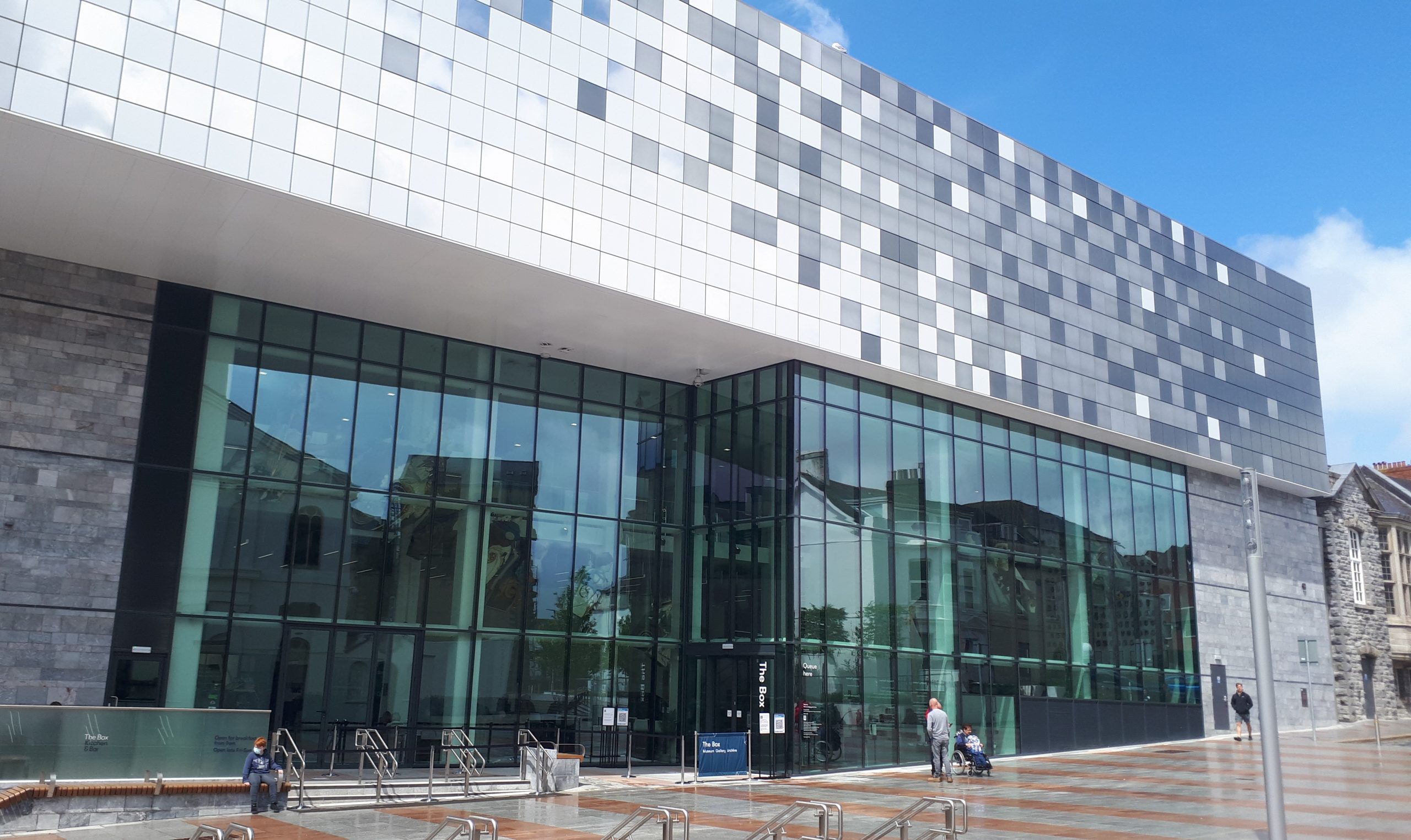
The Box, Plymouth which opened last year with Mayflower 400: Legend & Legacy Exhibition © Anthony Roach
It was later revealed to me that Worcestershire had contributed not one, but several ‘Pilgrims’ who travelled to America. The most celebrated of these being Edward Winslow. Edward would play a vital role, not only in supporting the Leyden (also pronounced Leiden) separatist community leading up to their departure as well as the establishment and administration of the New Plymouth colony. Indeed, his temperament, good-nature and leadership would prevent tragedy unfolding with the native Wampanoag people. It was with the knowledge of Winslow, as well as a desire to see the new Plymouth City Museum (now called ‘The Box’, where I once volunteered) that I returned to Plymouth earlier this year. Like the Mayflower celebrations, it’s reopening had been delayed due to the Pandemic but features a ground-breaking ‘Mayflower 400: Legend and Legacy’ exhibition exploring how ‘The Mayflower connects people across land, sea and time’ available until early 2022.
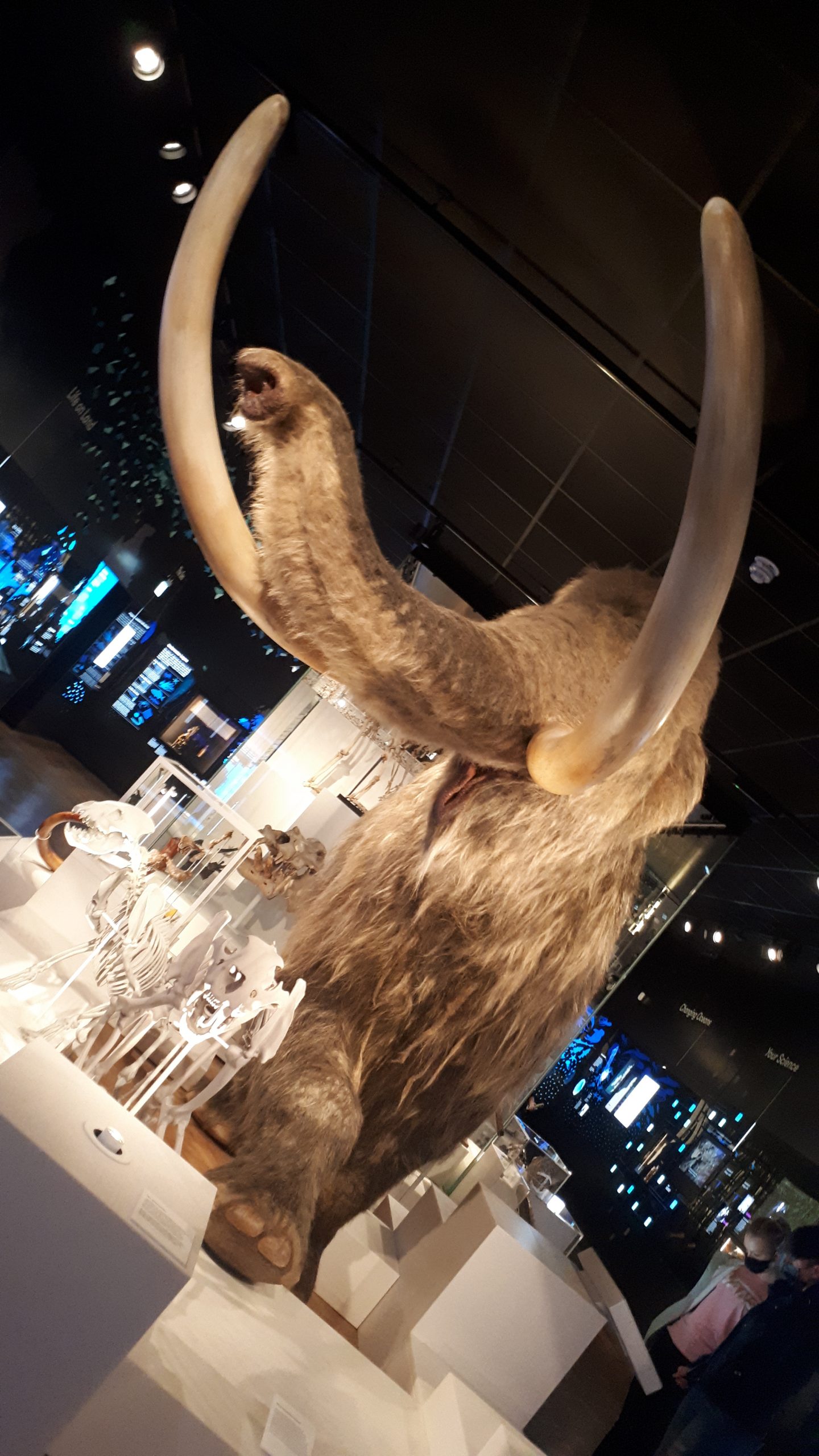
The reconstructed Woolly Mammoth in The Box’s new Mammoth Natural History Gallery © The Box, Plymouth
As a former Archaeologist and keen naturalist, I was blown away by The Box’s new Mammoth interactive gallery about the geodiversity and natural history of the south west (with a life-size woolly mammoth rumoured to have hair similar to that worn by Chewbacca in Star Wars); an Active Archives gallery with documents displaying Plymouth’s rich Elizabethan history with a public research space to learn more about the city and a Media Lab which explores ‘the technologies, processes and people that have shaped the south west’s film and photographic heritage.’ It was great to see how a familiar building has evolved, both in its architecture and representation, exploring old and new stories using diverse collections with ambition, passion, and wit.
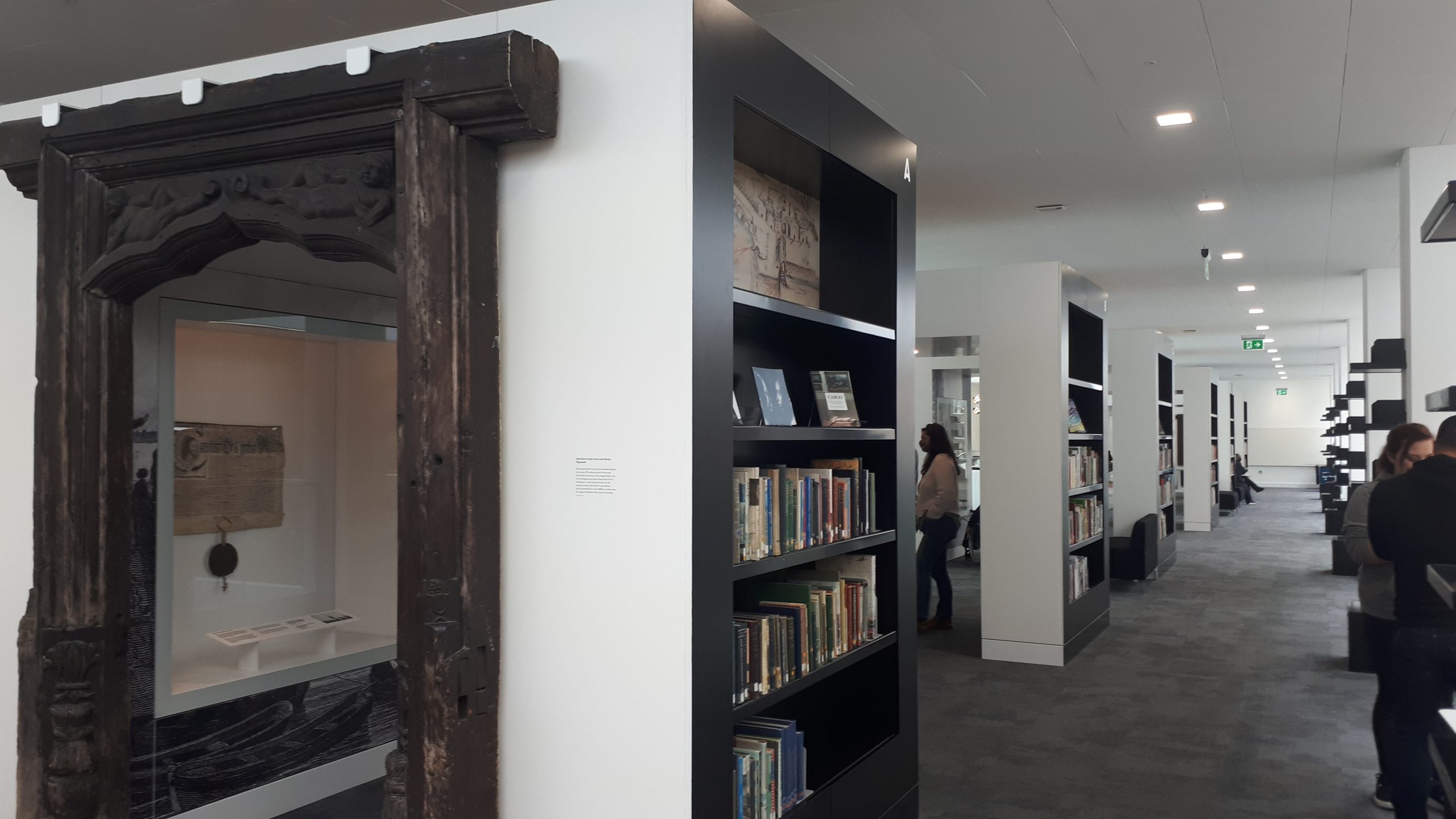
The ‘Active Archives’ displays at The Box, Plymouth © The Box, Plymouth
The Mayflower 400 exhibition charts the epic story of survival shown by the colonists, with new archaeological evidence and indigenous objects in partnership with the Wampanoag Advisory Committee. It acknowledges the conflict and impact of colonisation on the Wampanoag and using images from the exhibition and material from our archives, I will explore Edward Winslow’s family history in Worcestershire and his involvement, and that of the Wampanoag people in the key events of ‘The Mayflower’ story.
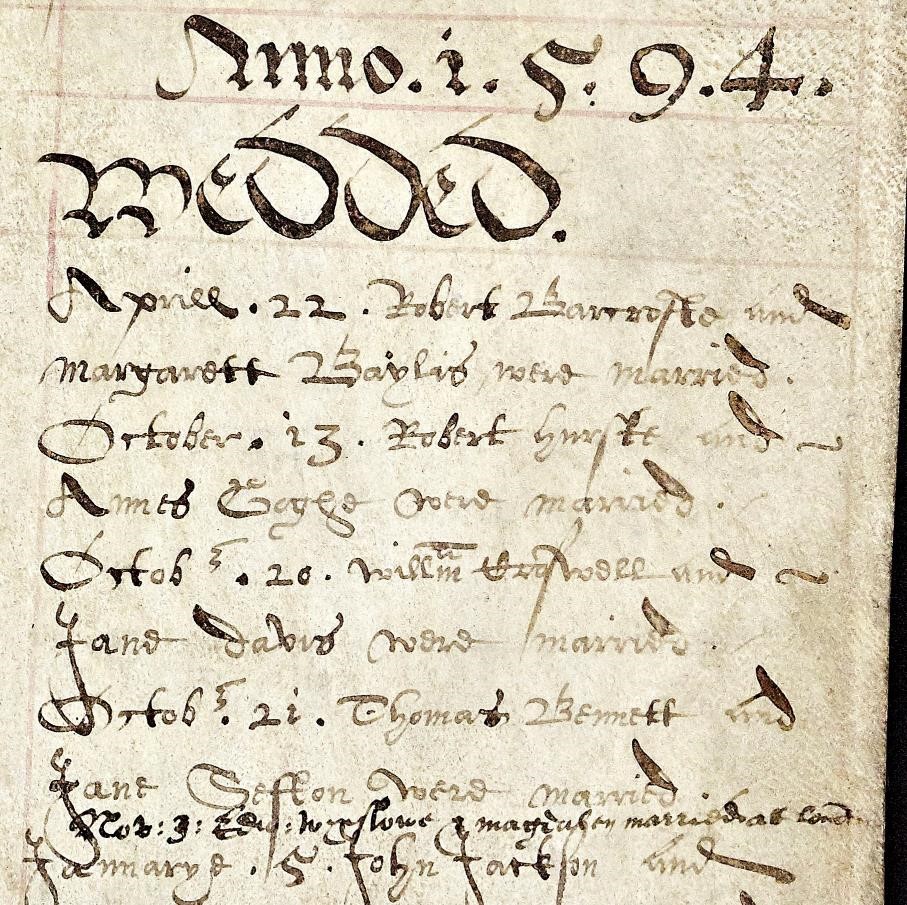
Marriage entry for Edward Wynslow & Magdalen Ollyver, Droitwich St. Peter, Nov 3 1594 Ref b850 BA5476 Vol 1a (i) © WAAS
The ‘Worcestershire Winslows’
Edward was one of ‘Five Brothers’ of Worcestershire who would go to New England and included John, Kenelm, Gilbert and Josias Winslow. They were of Yeoman stock and trained in useful trades (Kenelm, D., 1957). Edward was born in Droitwich in 1595 to his parents Edward (Senior) and Magdalen and his Baptism record is shown in the St. Peter register for that time. What’s unusual is Edward’s father married in London (St. Bride’s Church, Fleet St.) with an entry later inserted into the Droitwich register which reads ‘Anno 1594 Wedded Nov. 3. Edw. Wynslowe & Magdalen married at Lond.’ along with the birth dates interlined later with the Baptisms of his children. The explanation given was that Edward Winslow being a Churchwarden, from a family of very good standing in the County (whose family had lived in the area for generations) and having been good friends with the Vicar, persuaded him to insert his marriage and other entries into the register.
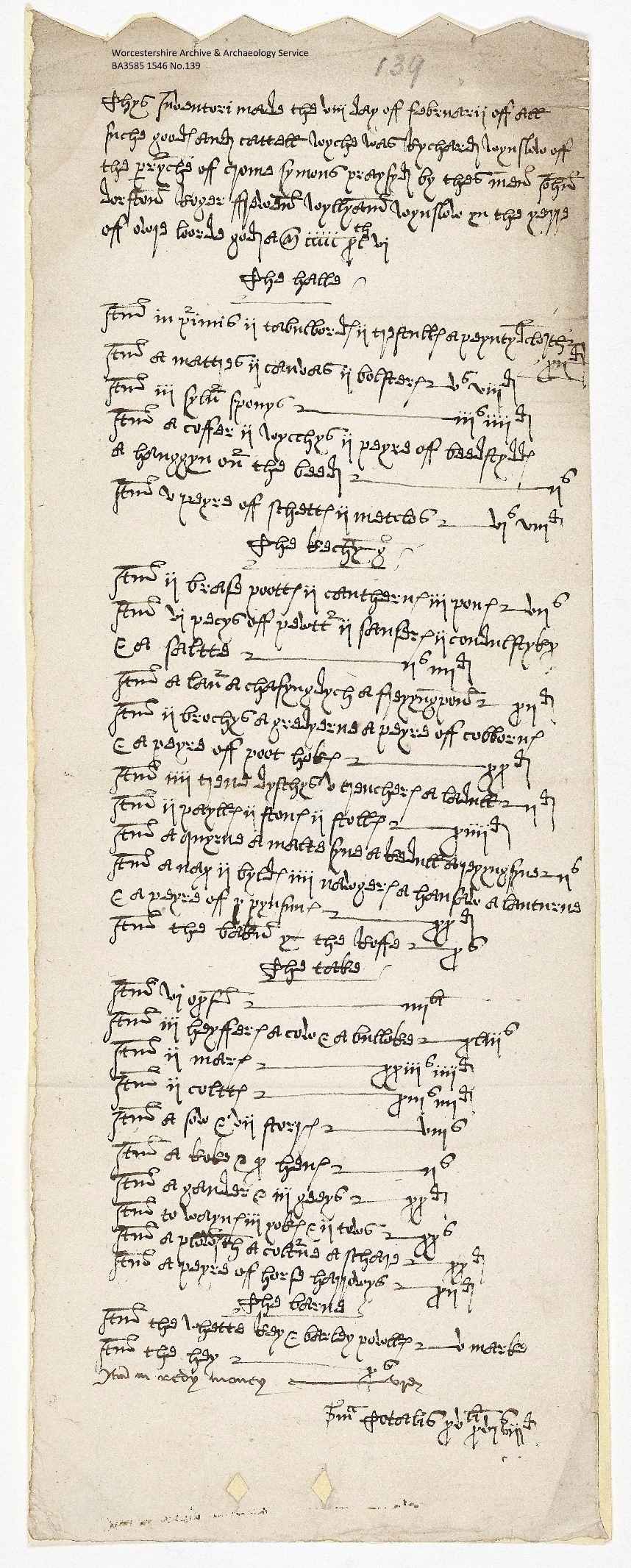
Inventory of Richard Wynslowe, Crome Symons 1546 No 139 Ref: 008.7 BA3585 © WAAS
We can trace Edward Winslow’s ancestors starting with Richard Winslow, his great, great grandfather who farmed at Earl’s Croome. According to D. Kenelm Winslow in Mayflower Heritage ‘If we imagine a square of country about 4 miles or so, south of Worcester City, in the Severn Valley..[…]..contained in the square are the villages of Earl’s Croome, Severn Stoke, Clifton and Kempsey.’ Following Henry VIII’s Dissolution of the monasteries in 1536, Richard bought up lands in Croome Manor, to the benefit of his large family. Whilst his will no longer survives (although we do have what we believe is his inventory dated 1546) he named his family precisely in it and charmingly refers to a cow as the appropriately named “Fil-Payle”. Through this will and manorial records we believe his youngest son Thomas moved to near-by Kerswell, a hamlet within the parish of Kempsey.
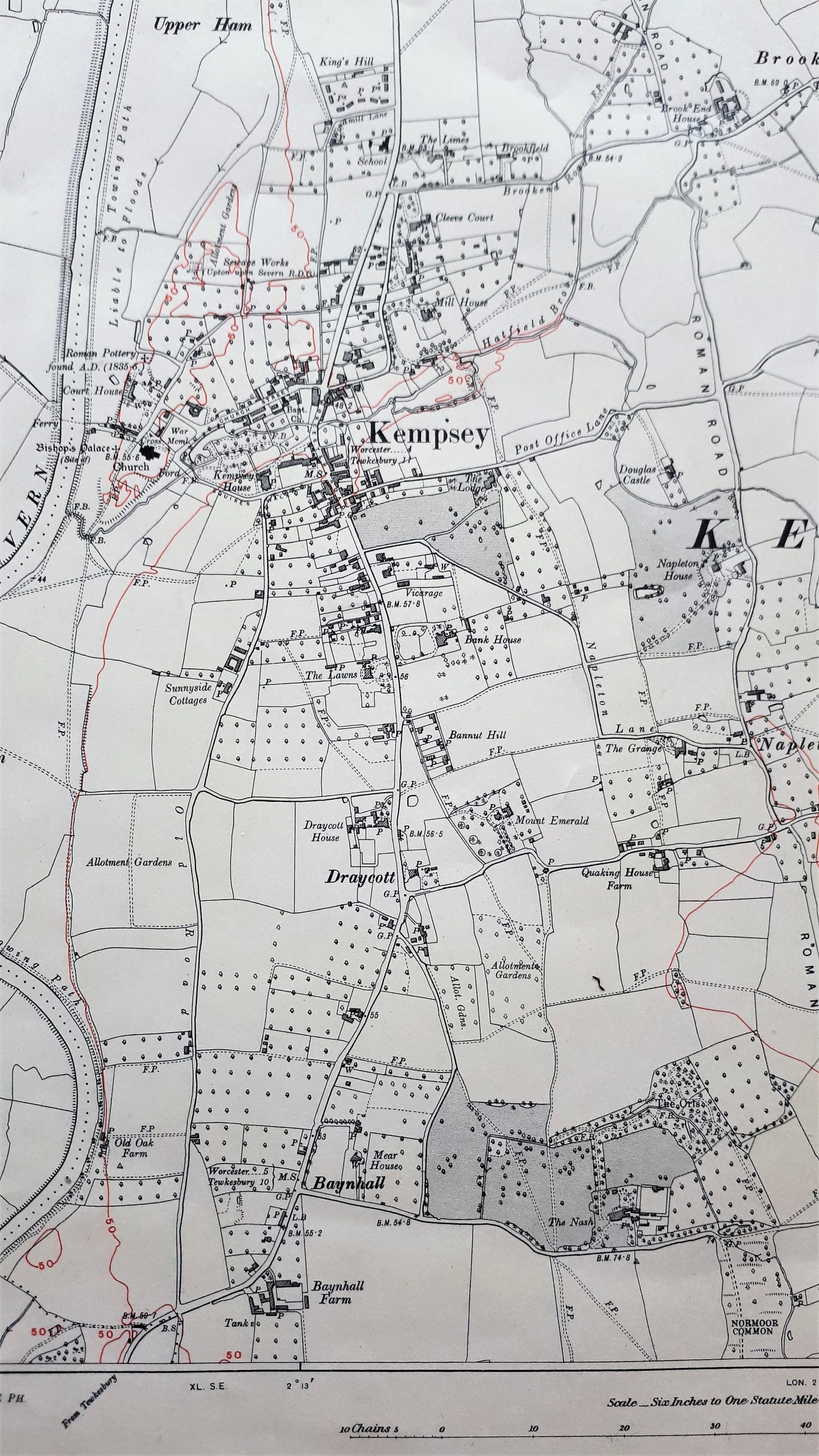
A section of the 25 inch OS Map (XL.1930) showing Kempsey, nearby Draycott and The Nash once ‘owned’ by Kenelm Winslow
Kenelm Winslow, son of Thomas of Kerswell, sold the family farm to Sir John Buck which Edward fondly remembers as a child and moved north into Worcester City. Edward would one day name his estate in New England, ‘Careswell’ a phonetic spelling of the old family farm he had loved as a child. According to Croome Estate manorial records, Kenelm appears to have later owned Draycott Manor, Kempsey which then passed to his son John, as shown in the Croome Court roll translation. Kenelm died in 1607 and his will is held by us at Ref b736 222/92. In it he says ‘I devise & appt. v s. in money to the pore of the psh of St. Andrew parish’. Whilst records show he died in St. Andrew parish, due to his move into Worcester City, including to marry his wife Katherine who he describes as ‘my ever loving wife’ (her maiden name is believed to be Bucke) no evidence of his marriage or burial entry have been found despite a detailed search of Worcester City parishes (a transcription of his will and inventory in Edward Winslow, King’s Scholar and Printer by George G. Wolkins at LP 929.2 WIN).
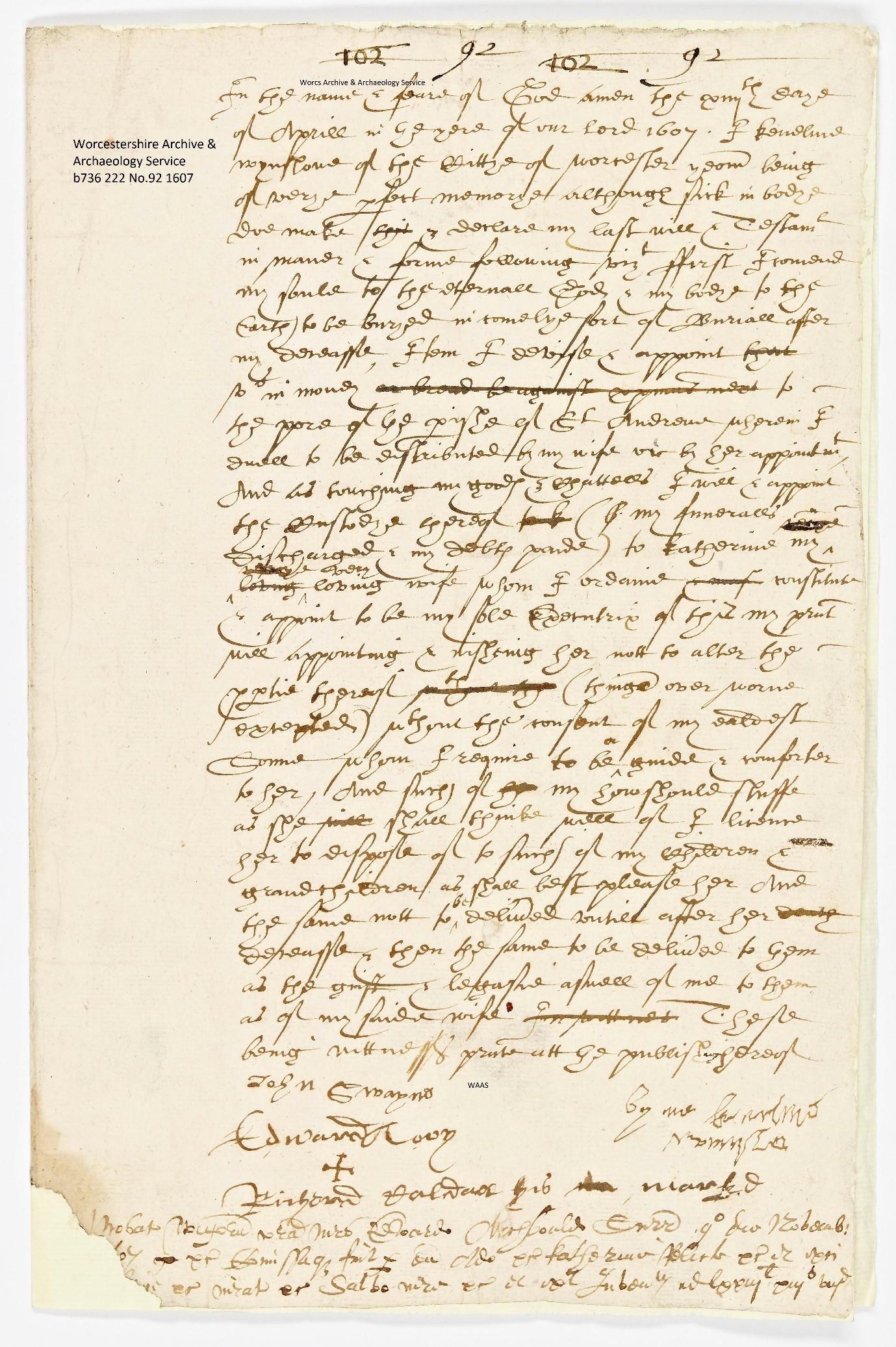
Will of Kenelm Winslow, b736 222, No 92 1607 © WAAS
However, in the Worcester All Saints register (combined with St. Andrew) several baptisms for his children can be seen which include Mary (Nov 15, 1562), John (Feb 2, 1565), Roger, (Aug, 11, 1568), Margaret (April 1st, 1572) and Thomas, perhaps named in honour of his father (July 12th, 1575).
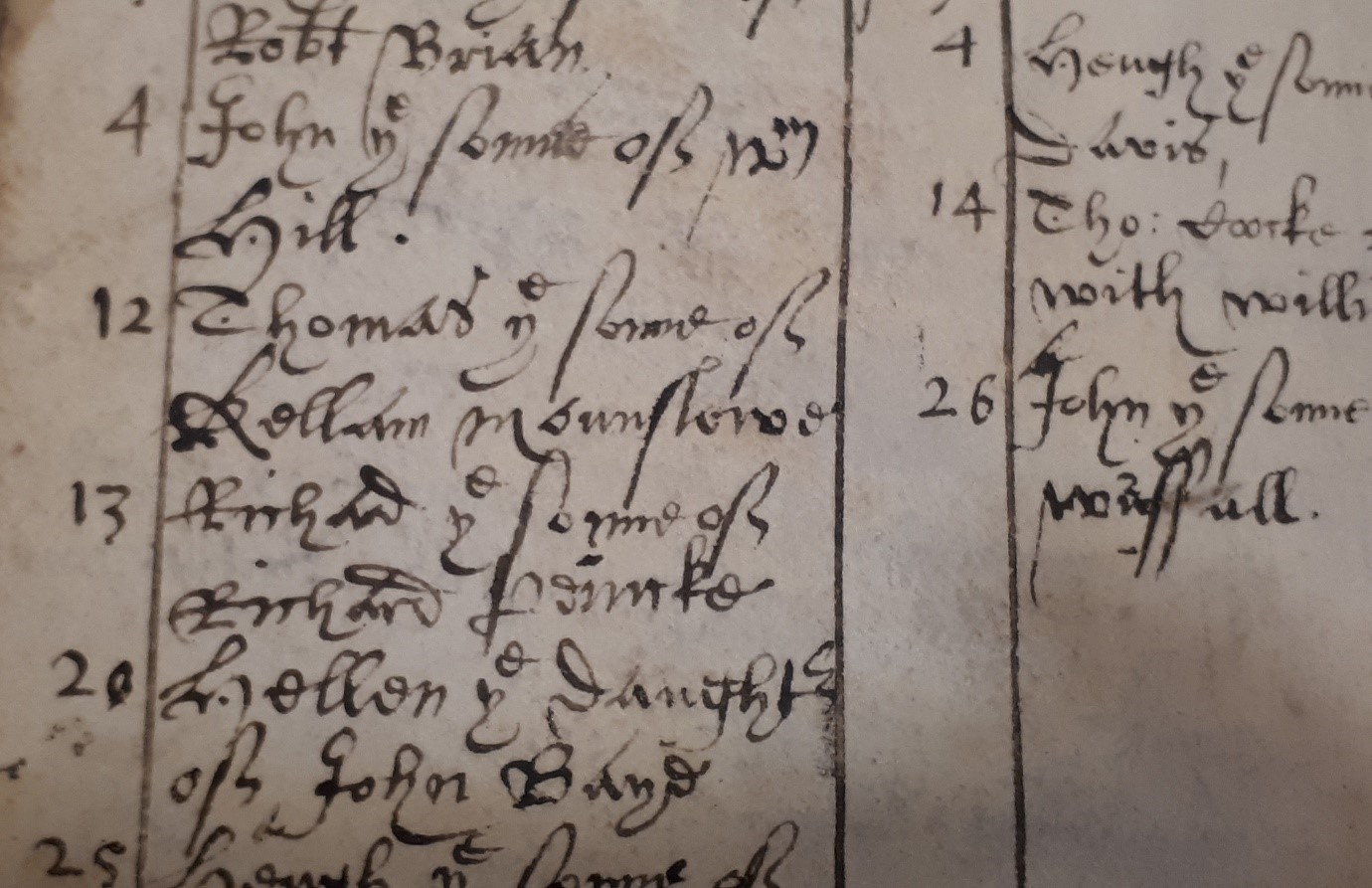
Baptism entry for Thomas Winslow, Son of Kenelm Winslow July 12th, 1575, Worcester St. Andrew & All Saints Ref: b850 BA2333.46 Vol 1 © WAAS
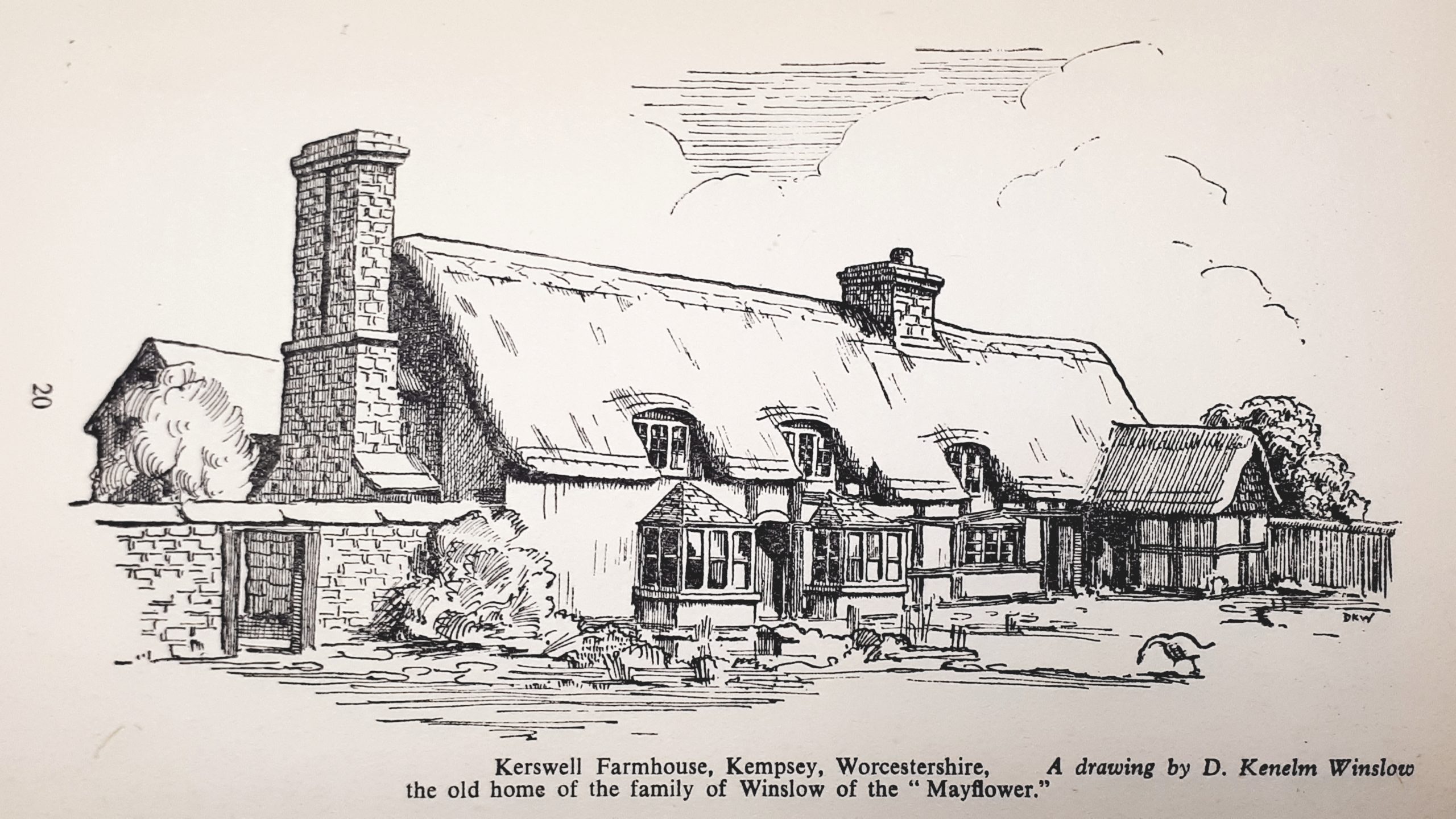
A drawing of Kerswell Farmhouse, Kempsey, Worcestershire © D. Kenelm Winslow, 1957
More excitingly, the site known as ‘Kerswell’ once ‘owned’ by Kenelm Winslow is still in use today referred to as The Nash and was recently for sale if you have a spare £3 million pounds. It is described as follows in Volume III: Part 2 of the Victoria County History of Worcestershire ‘Sir William son of John Clopton died in 1420 holding a messuage and a carucate of land in Kerswell…’ it goes on to say that ‘this estate apparently passed to John Newport and later his grandson Sir Richard Newport and was sold by him to Kenelm Winslow, of whom it was purchased by Sir John Buck’. Similarly in Nash’s History of Worcester the lands of Kerswell are mentioned by saying ‘these three last tenants also held lands, the inheritance of Sir Richard Newport, which were afterwards sold to Kenelm Winslowe..[…] and which lands in the White book of the bishopric are called ‘Newport’s place (Nash, 1799, Pt ii, p20).
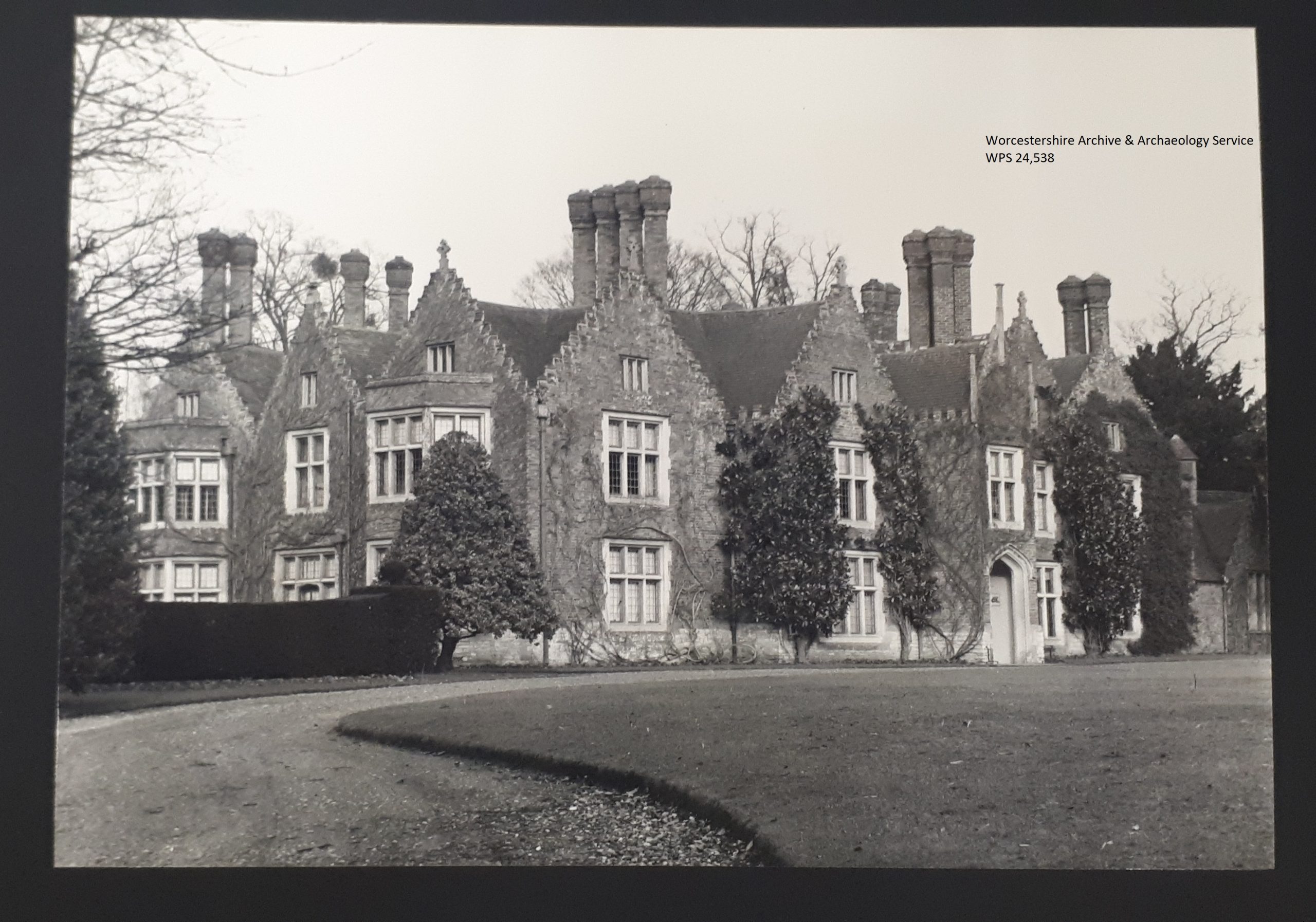
The Nash, Kempsey, January, 1962 Ref: WPS 24538 © H.D. Small
Prior to selling the estate to Sir John Buck, it had passed unbroken from father to son as described in the Pedigree shown below from the Visitation of Worcestershire (1569). After Kenelm, it was later bought by Sir William Temple, eventually passing to Sir Richard Temple in 1874. Though recent research by Brandon Fradd in The Winslows of Worcestershire, 1400-1700 has shown that based on court rolls, Kenelm was first a tenant and not the owner of Newport’s place (Fradd, B., 2009) as described by the Winslow Heritage Society. Alongside The Nash, Kenelm also owned nearby Clerkenleap, also described in the Victoria County History as ‘at one time belonging to the Winslows’ and still survives to this day. The estate was purchased about 1650 by John Nash and eventually passed to Treadway Russell Nash, the historian of Worcestershire’.
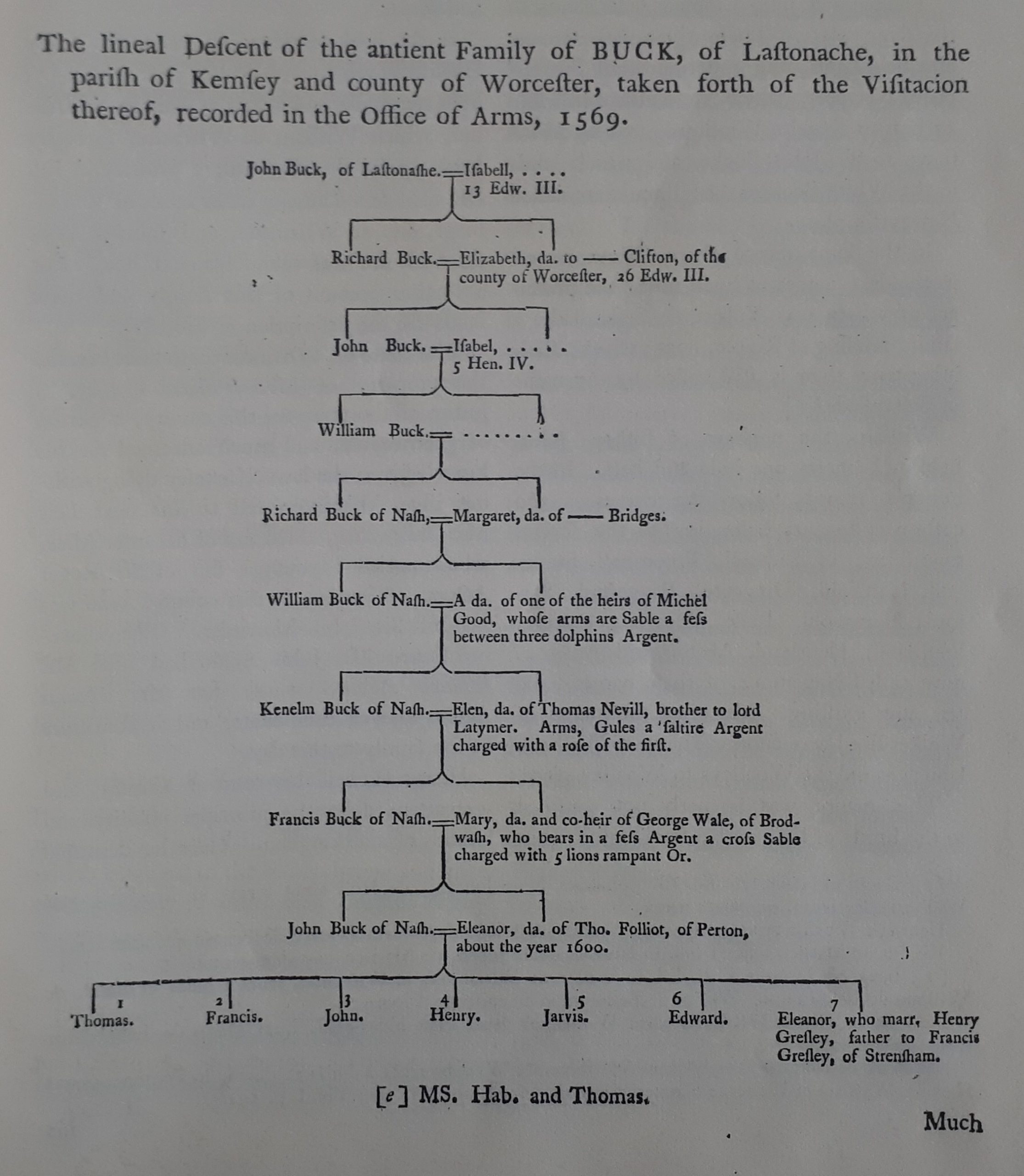
Pedigree of Sir John Buck from the Visitation of Worcester (1569) in Nash, 1799, Pt. II pg.19
Kenelm’s son, Edward (Senior) moved north where he set up in business extracting the famous Droitwich salt, in fact, even renting his salt-pans from a member of the treasonous Winter family who would later be involved in Guy Fawke’s Gunpowder Plot of 1605 – no doubt creating some anxiety for Edward at the time. Salt during this time was essential in preserving meat and treating the by-products of sheep.
Edward Winslow (Senior) made regular trips to London to sell what they produced such as sheepskin for book binding and parchment to the bookmen (the famous printers and bookbinders of the capital) scribes who carried on their business in the churchyard of St Pauls cathedral in London. It is therefore no surprise that Edward, exposed to this industry would be fascinated by the printing and bookbinding process. Following his study at the famous King’s School, on August 19th 1613, Edward was apprenticed to Stationer John Beale with the register at Stationers’ Hall, London recording “Edward Winslowe, sonne of Edward Winslowe, of Clifton, in the Countie of Worcester, Gent, hath putt himself an apprentice unto John Beale, citizen and stationer, for the term of eight years”
After serving three years of his apprenticeship, Edward, who became sympathetic of a Puritan community exiled in Leyden (who ran a printing press there on which they printed anti-episcopal propaganda smuggled into England) was asked if he would like to go and work on the ‘Pilgrim Press’.
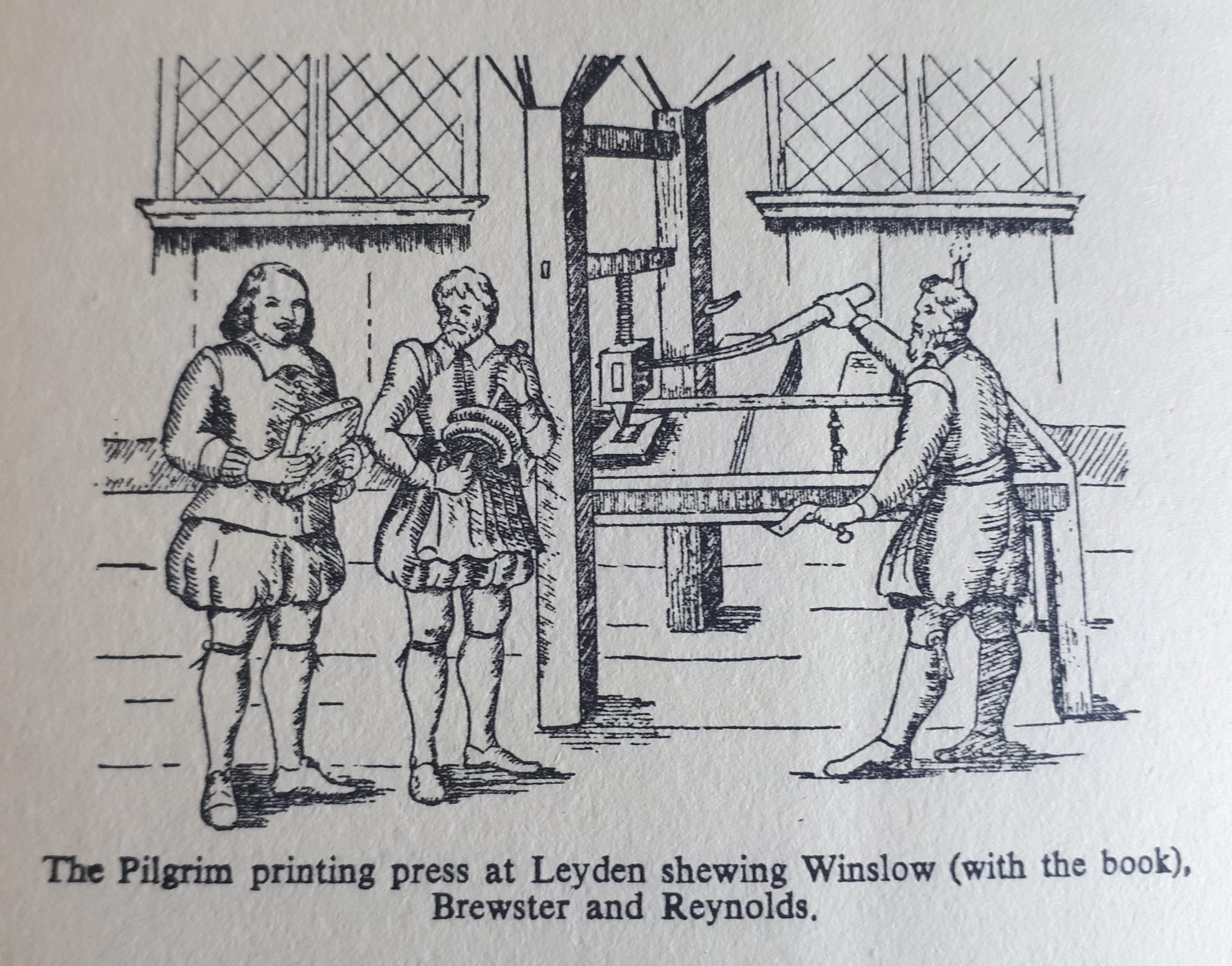
The Pilgrim printing press at Leyden © W. Sterry Cooper, 1953
The Pilgrims and Mayflower
The Puritans as the ‘Leydeners’ were also known had escaped the bullying of King James’ Bishops and needed assistance. The Dutch found their pious guests more than a trifle off, but they respected them for their decency and sturdy faith. In the London that Edward had left – the topics of the time included religion, colonial development – and fishing. Edward had heard all about Captain John Smith, “Govuernour of Virginia and Admirall of New England” (of Pocahontas fame) who had been addressing enthusiastic pamphlets about the possibilities of the North American continent to the ill-fated Charles Stuart, then Prince of Wales. Of New England, Smith wrote “The water is deepe, close to the shore,” “….there are many rivers and fresh springs: few Salvages, but an incredible abundance of fish, fowle, wild fruits, and good timber”. Edward Winslow brought as gossip to the Leyden Community about ‘the delectable coast of New England’, suggesting to them a means of escape.

A display of the journeys made by Speedwell and Mayflower in Mayflower 400 Legend and Legacy © The Box, Plymouth
In 1619, after printing yet another explosive religious pamphlet which ran contrary to the religious views of King James, the press was ordered to be closed and the culprits’ to be extradited (the Dutch closed the press down, but still protected their English guests). The writing was on the wall, rather than on the printing block it seemed, as the Leyden community realised that they had to move on. In response to the hostile King James, The Leyden community prepared a document, asking if they could proceed to America and ‘go fishing’, a craft of which they knew very little about. Pleased that he would finally be rid of the Puritans, the King agreed, maybe secretly hoping the ‘Salvages’ would get them. The journey to the New World would take place by two ships, Speedwell and Mayflower – funded by a group of London Merchants who in-return would receive shipments of skins, timber etc.
Speedwell was appointed to take the first group of Leydeners to join Mayflower in English waters but it became apparent after two failed attempts to leave port that Speedwell wasn’t seaworthy to make the passage. Mayflower a vessel of 180 tonnes under the command of Captain Christopher Jones would have to make the voyage. Those who were disheartened were put ashore and the remainder on Speedwell transferred to Mayflower. The 102 passengers were not a homogenous group. 41 were of the Leyden Community. The rest consisted of ‘extras’ from London and other parts of England. Most were of Puritan persuasion but unlike ‘The Pilgrims’ they did not necessarily seek liberty to express their disparate or dissenting views, moreover they were seeking a better life, common to emigrants in any age.
Read Part 2 for the next part of the story.
Further Information:
Mayflower 400: Legend and Legacy
Books:
- Kenelm Winslow, Mayflower Heritage (1957)
- Sterry Cooper, Edward Winslow of the “Mayflower” (1953)
George G. Wolkins, Edward Winslow, King’s Scholar and Printer (1951)
All available at The Hive, Level 2: Local Studies – L 929.2 WIN
Very Interesting.